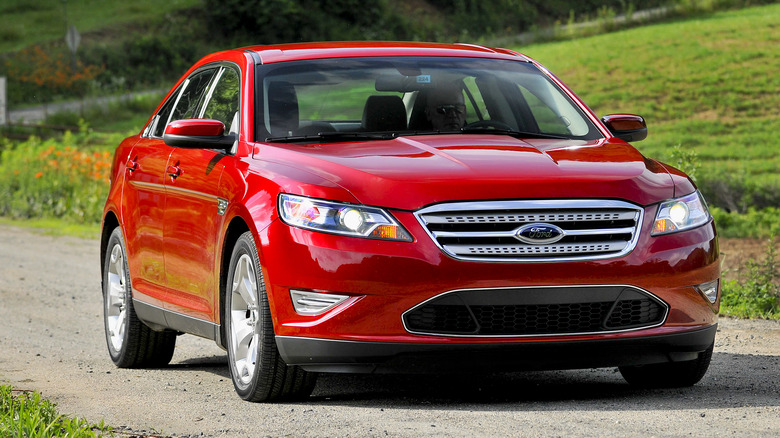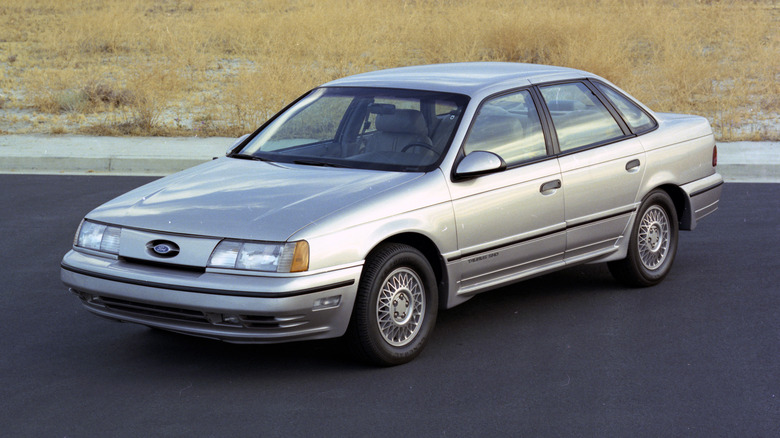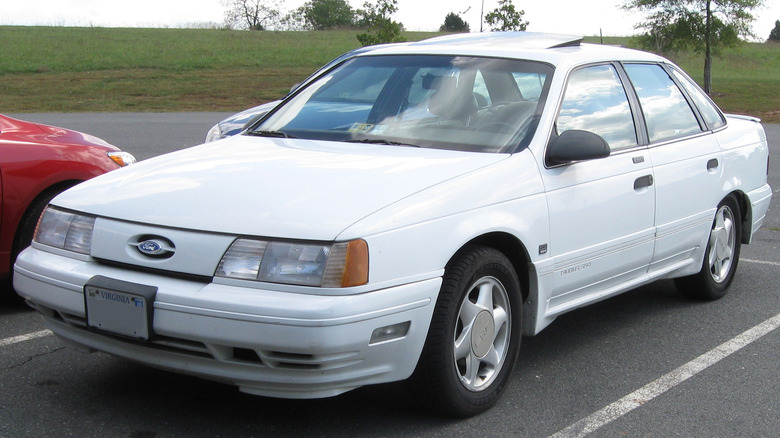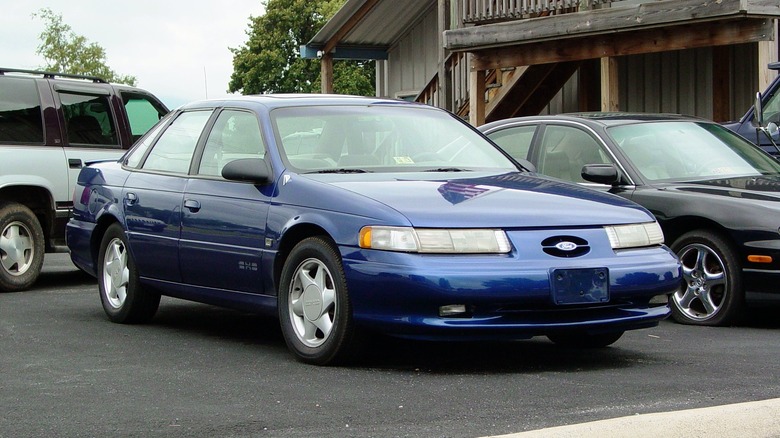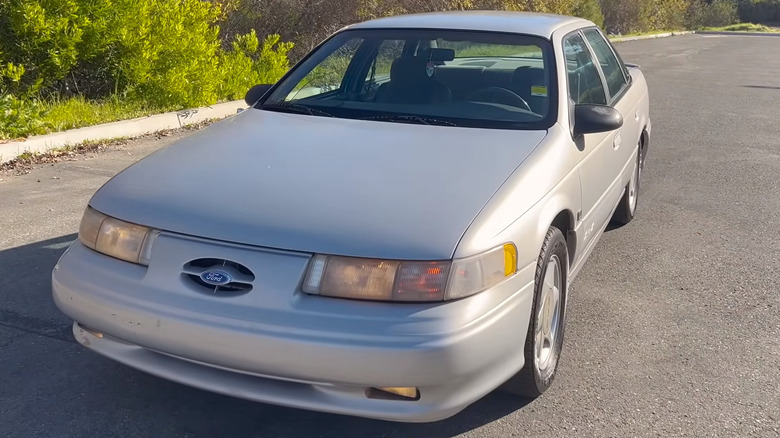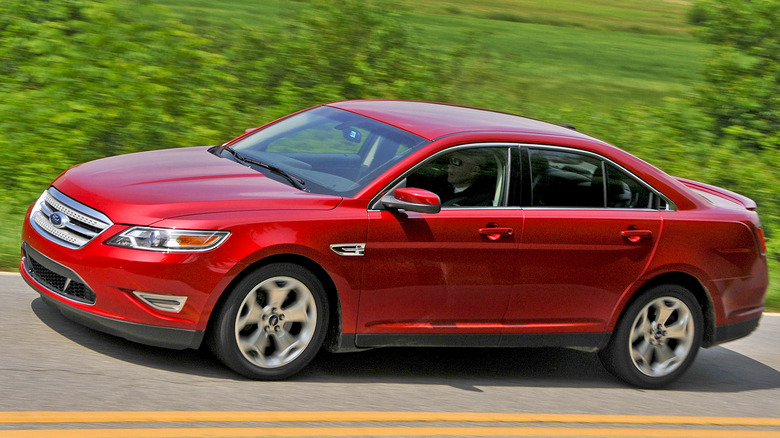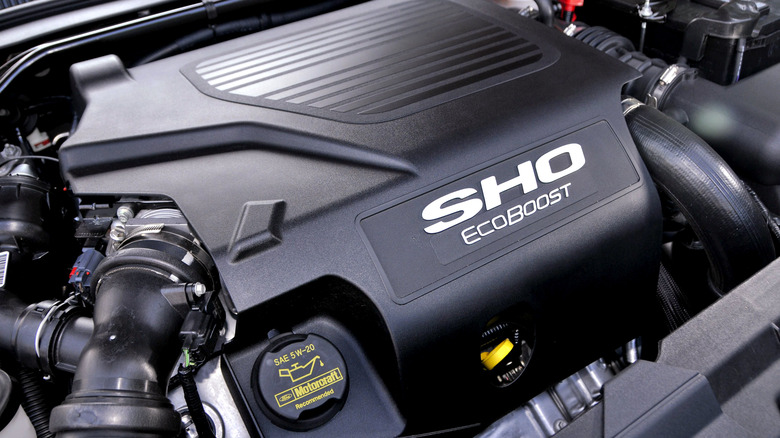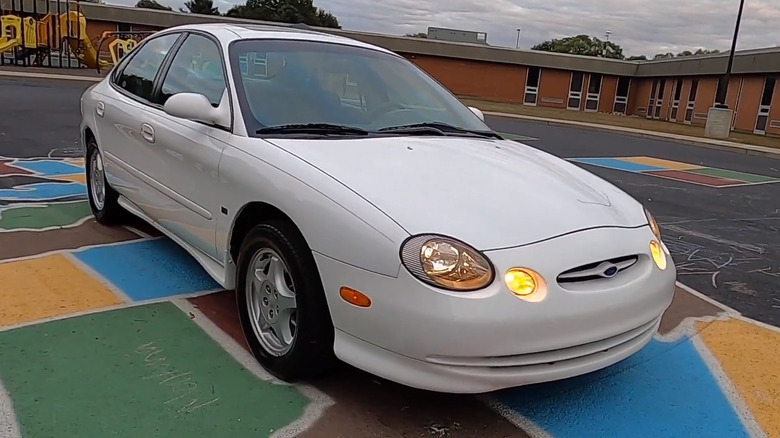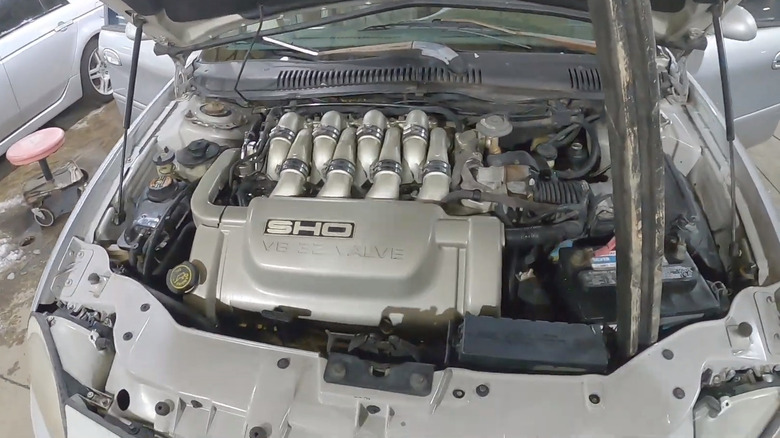Every Ford Taurus SHO, Ranked Best To Worst
The term "sleeper car" is often used as a sign of respect — it means a car offers a higher level of performance than you might expect at first glance, letting it slip under the radar on the road. However, it's not always a good thing, at least not from a manufacturer's perspective. The Ford Taurus SHO is a prime example of this: While, on paper, the first-generation SHO offered a groundbreaking amount of power for a bargain price, it was a little too close in appearance to the standard Taurus, and its sales figures never reflected its performance potential. Sure, it gained a niche following over the years it was on sale, but today, it's not remembered nearly as fondly as some of its other competitors from the era.
After an underwhelming third generation saw the model axed from Ford's lineup, the Taurus SHO spent some time out of the spotlight, before returning for a fourth and final generation in 2010. The death of the Taurus sedan signaled the end for the SHO line, a rather unceremonious finale for what's arguably one of Ford's more underrated sleeper cars. Here, we're taking a look back through each generation and comparing the relative strengths and weaknesses of each.
First generation: History
The first Taurus SHO is still arguably the best of the bunch, with its high-performance, front-drive formula being hailed as a breakthrough when it launched for the 1989 model year. It was, quite simply, unlike anything else an American manufacturer had made before. Its 220 horsepower V6 engine gave it remarkable performance off the line, and despite being front-wheel drive, it handled well too. To put the SHO's power into context, a Ferrari 328 GTS from the same era made 267 horsepower and could sprint from 0-62 mph in 6.4 seconds. The SHO took 6.7 seconds to get to 60 mph, making it only around 0.3 seconds slower than the Italian supercar.
Its performance was made all the more shocking given its price, which came in just under $20,000 in base-spec form. The only faster sedans on the road were more than double the price. It's easy to assume, then, that given this exceptional bang for the buck, Taurus SHOs would be practically flying out of showrooms, especially given the success of the regular Taurus sedan. In fact, the opposite was true — Ford missed its 20,000 unit sales target in the first year, managing only to shift around 15,000 units. The following year, just 8,000 examples were sold, and sales continued to be sluggish through to the launch of the second generation.
First generation: Powertrain
So how exactly did Ford manage to make the first-gen car so fast? The answer is it didn't, at least not without some help. The groundbreaking engine that powered the car was in fact designed and built by Yamaha, which took the standard 3.0-liter V6 Taurus engine and treated it to a thorough overhaul. That overhaul was so all-encompassing that only a few small parts were shared between the two engines, with everything else on the Taurus SHO engine being completely new.
The engine, reportedly referred to as the "Shogun" during development, was limited to 7,300 revolutions per minute, although it could allegedly hit more than 8,500 revolutions per minute in de-restricted form. The only reason its rev range was capped was that other engine-dependent Taurus components simply couldn't withstand a higher redline. Most of the other alterations made to the Taurus SHO were primarily to compensate for this more powerful engine, with Ford's engineers having to adapt the humble Taurus platform to ensure the car was still driveable despite the extra grunt. Today, the SHO's V6 is hailed as one of the greatest American V6s ever made, even if the car it debuted in still remains an under-the-radar cult classic.
[Featured image by IFCAR via Wikimedia Commons | Cropped and scaled | Public Domain]
Second generation: History
The second generation of the Taurus SHO arrived for the 1992 model year and kept nearly all the oily bits from the first generation. The 3.0-liter V6 engine and chassis were unchanged, but the new gen featured some revised bodywork to address earlier concerns that the SHO looked a little bit too much like the regular Taurus. New bumpers were fitted, alongside new fog lights and side cladding. The following year, a spoiler was added to highlight the SHO's sportiness, although the overall effect was still quite subtle. It was now easier to tell the SHO from its run-of-the-mill sibling at a glance, but it still didn't exactly shout about its performance prowess.
The addition of an auto 'box alongside the standard manual transmission for the 1993 model year boosted sales significantly, with annual unit sales eclipsing 20,000. It's this second-generation vehicle that's probably best remembered as the "peak" SHO design, even if the underlying mechanicals didn't change from the first-generation car.
[Featured image by Ben Schumin via Wikimedia Commons | Cropped and scaled | CC BY-SA 2.5]
Second generation: Powertrain
The same 3.0-liter V6 engine from Yamaha was carried over to the second generation, and initially, it was the only option available. However, with the launch of the automatic transmission SHO in 1993, a larger 3.2-liter engine was also offered. This was primarily to compensate for the auto 'box, but the end result was a little more torque from the 3.2-liter and exactly the same horsepower. There have been some reports of owners swapping the larger engine into manual transmission cars to gain a slight performance upgrade, but any significant power boost will still require aftermarket intervention.
As well as being powerful, the SHO V6 was unique in that it was surprisingly economical, too. City fuel economy was officially pegged at 21 mpg, a respectable figure for any sedan at the time. However, its highway rating was even more impressive — it claimed 34 mpg. Buyers didn't know it at the time, but this second generation would be the last to use the Yamaha V6 engine. The third-gen car packed a new V8, which was neither as lively nor as reliable as its six-cylinder predecessor.
Fourth generation: History
The third-best generation of the Taurus SHO is arguably the most recent generation. Launched for the 2010 model year, it was a different beast from the original — not only was it considerably larger in both size and weight, but it was also considerably more powerful to try and offset that gain in mass. It was also the first SHO to use a Ford engine rather than a Yamaha one, although there were some reassuring similarities for long-time fans of the nameplate.
For starters, it kept its low-key looks, and at first glance, was practically indistinguishable from the standard Taurus. It also kept its front-biased weight distribution for similar handling dynamics to previous front-wheel drive SHOs, even though the newest car packed all-wheel drive as standard. The fourth-gen also saw the return of a V6 engine, albeit with twin turbos this time around. Although the car was far from cheap to buy new, it has depreciated significantly in the years since it was first offered, and it's now one of the fastest cars you can buy for under $10,000.
Fourth generation: Powertrain
The 3.5-liter EcoBoost V6 under the hood of the fourth-generation SHO made it suitably rapid, but it lacked some of the standout qualities that made the original Yamaha V6 so special. The twin Garrett turbochargers were a key element in offsetting the car's substantial weight, providing an extra dollop of boost to give the SHO punchy straight-line performance, but they made for a less enjoyable drive than the high-revving nature of the original V6.
Power was put to the ground through a six-speed automatic transmission, and no manual was offered. The bigger engine was a far cry from the first-generation V6's fuel-sipping nature, demanding frequent trips to the gas station even when driven at everyday speeds. Not that the car could achieve groundbreaking speed anyway — it was limited to 133 mph, which strangely enough was 10 mph slower than the original 1989 car. At least 60 mph arrived in 5.2 seconds, a significant improvement over its predecessors.
Third generation: History
The third generation of the Taurus SHO is the least coveted of all, because it ditched many of the perks that made the previous generations worth buying. The five-speed manual transmission was axed, with only a four-speed automatic available, and the V8 co-developed by Yamaha and Ford failed to live up to the bar set by the V6. Its styling arguably hasn't aged well, either — then again, that's more a reflection of Ford's overall design language at the time rather than the fault of the SHO itself.
It failed to generate much interest from buyers, and its low sales were the reason that the SHO nameplate was axed after the 1999 model year. It's rare to find examples in good condition today, partly because of those low initial sales and partly because the third generation never garnered the same enthusiastic fanbase that other generations of the model enjoyed.
Third generation: Powertrain
The third-generation SHO was the only one with eight cylinders, a decision that Ford reportedly made in an effort to rejuvenate the Taurus line and entice new customers. However, the performance improvements from the engine switch were limited — the new engine delivered 235 horsepower, only 15 horsepower more than the outgoing model. An improvement, for sure, but not one that had buyers rushing in to get their hands on this latest iteration.
Torque gains were similarly unremarkable: The V8 produced 230 pound-feet, while the previous generation V6 made 215 pound-feet. To make matters worse, the V8 developed a reputation as being unreliable, with reports surfacing of blown engines not long after the first examples made it to customers. Compared to what else was on offer on the market at the time, the Taurus SHO simply couldn't compete. The original SHO might have led the revolution in making American sports sedans not only competitive but affordable to the masses, but the third generation of the car proved its time as a groundbreaker was well and truly behind it.
